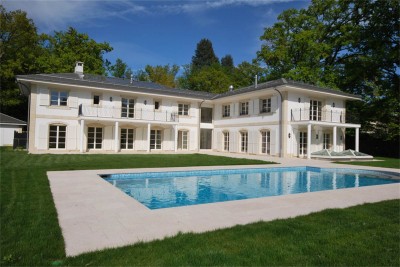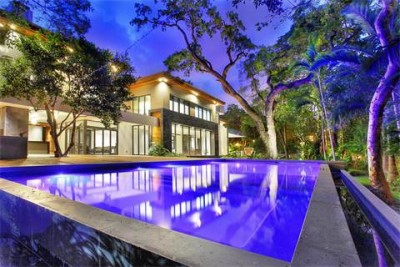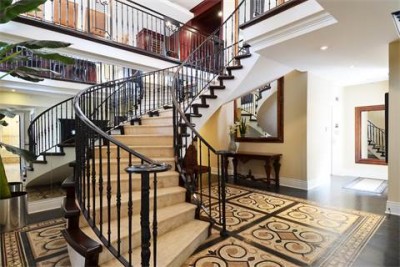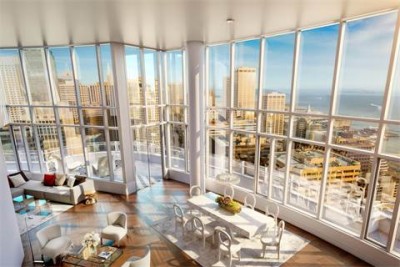 Sotheby's real estate listing in Los Angeles
Sotheby's real estate listing in Los Angeles
Ultra-high-net-worth individuals are buying second and third homes in markets outside of traditional global cities, according to a new report by Wealth-X and Sotheby’s. In addition to looking in cities beyond London, New York, Hong Kong and other longtime market leaders, multi-home consumers are also concentrating on homes that fit specific lifestyle needs. Although UHNWs tend to be older, the younger members are making lasting impacts on the real estate market.
"While we do not have the average age of green homeowners, as it’s difficult to identify them all, we know the average age of UHNW individuals within the tech industry is nearly 54, which is significantly younger than multi-homers and the average UHNWI," said David Lincoln, director of research at Wealth-X. "Anecdotally, these tech entrepreneurs have a propensity for the green and smart homes."
“UHNW Multi-homer Report” contains a demographic overview of consumers with multiple homes, examines each of four different types of specialty homes and details the markets of Long Island, NY, Geneva and Miami. Safe and sound The average UHNW who owns multiple homes has a net worth of $165 million and is 63 years old, compared to $141 million and 59 for UHNWs in general. Ninety percent are married. Eighty percent of UHNWs – defined as those with at least $30 million in net assets – own at least two homes and more than half own at least three. Additionally, five years ago, 11 percent of UHNWs’ non-primary residences were international, but today that number is 16 percent. Sotheby's Geneva real estate listing
Among the emerging trends in luxury real estate identified in the report are environmentally friendly homes. Features such as solar power, geo-thermal heating, rainwater collection system renewable materials and touch technology are particularly important to younger UHNWs.
The market has been quick to respond all over the world. LEED-certified homes on the U.S. market were up nearly 10 percent over the last year and double that in Canada, while BREEAM-certification rose over 14 percent in the United Kingdom with increases in green homes throughout Western Europe as well. In China, government incentives have spurred a 19 percent increase in environmentally friendly construction.
“The sustainable home marketplace is experiencing a monumental shift in consumer perception and understanding,” said Channing Boucher, broker associate for Benson Sotheby’s International Realty, in a statement. “Today’s homebuyers are better educated about the opportunity and therefore place a higher value on features like improved indoor air quality, energy-efficient electrical, plumbing and heating systems and water-saving equipment and appliances.
"And, as cost differentials for green-built versus conventional code-built homes shrink, the time horizon on the payback of the investment also shrinks, making eco-friendly homes more desirable and attainable,” he said.
Sotheby's Geneva real estate listing
Among the emerging trends in luxury real estate identified in the report are environmentally friendly homes. Features such as solar power, geo-thermal heating, rainwater collection system renewable materials and touch technology are particularly important to younger UHNWs.
The market has been quick to respond all over the world. LEED-certified homes on the U.S. market were up nearly 10 percent over the last year and double that in Canada, while BREEAM-certification rose over 14 percent in the United Kingdom with increases in green homes throughout Western Europe as well. In China, government incentives have spurred a 19 percent increase in environmentally friendly construction.
“The sustainable home marketplace is experiencing a monumental shift in consumer perception and understanding,” said Channing Boucher, broker associate for Benson Sotheby’s International Realty, in a statement. “Today’s homebuyers are better educated about the opportunity and therefore place a higher value on features like improved indoor air quality, energy-efficient electrical, plumbing and heating systems and water-saving equipment and appliances.
"And, as cost differentials for green-built versus conventional code-built homes shrink, the time horizon on the payback of the investment also shrinks, making eco-friendly homes more desirable and attainable,” he said.
 Sotheby's Miami real estate listing
“Smart” homes – those with energy management systems, security systems, HVAC control systems, health-monitoring and other technophile advancements – are also on the rise, in part because almost 10 percent of American UHNWs made their millions in the technology industry. The report notes that two-thirds of Sotheby's International Realty realtors have noticed more prospects inquiring about smart homes in the last year.
“Not only do owners enjoy the ease of integrating music and media into their everyday lives, but there is an added value to a smart home’s top-of-the-line security system,” said Ruthie Ravenel, sales and marketing director at Daniel Ravenel Sotheby’s International Realty. “We have a number of clients coming into our market to purchase second, third and fourth homes, and the ability to view security cameras and access alarm settings and home controls remotely has become the new norm for the ultra-high-net-worth individual."
The long sought-after private island is also in vogue, serving as a legacy and status symbol in the aftermath of the recent recession. Notably, however, some conservationists have been spurred to purchase private islands with the goal of preserving the island’s natural ecosystem.
Sotheby's Miami real estate listing
“Smart” homes – those with energy management systems, security systems, HVAC control systems, health-monitoring and other technophile advancements – are also on the rise, in part because almost 10 percent of American UHNWs made their millions in the technology industry. The report notes that two-thirds of Sotheby's International Realty realtors have noticed more prospects inquiring about smart homes in the last year.
“Not only do owners enjoy the ease of integrating music and media into their everyday lives, but there is an added value to a smart home’s top-of-the-line security system,” said Ruthie Ravenel, sales and marketing director at Daniel Ravenel Sotheby’s International Realty. “We have a number of clients coming into our market to purchase second, third and fourth homes, and the ability to view security cameras and access alarm settings and home controls remotely has become the new norm for the ultra-high-net-worth individual."
The long sought-after private island is also in vogue, serving as a legacy and status symbol in the aftermath of the recent recession. Notably, however, some conservationists have been spurred to purchase private islands with the goal of preserving the island’s natural ecosystem.
 Sotheby's Vancouver listing
Lastly, with the increase in second and third residences located in another country, serviced apartments that include housekeeping and security are also becoming more common.
The focus on individual markets consists of an overview listing the UHNW and billionaire population of that market, the average wealth and age of those UHNWs, average price per luxury home and per square foot and number of bedrooms, the most common work industry, the leading hobby, the percentage of UHNWs that are self made, the top countries for foreign owners and the social graph, referring to the number of and wealth of UHNWs the average UHNW is connected to.
Sotheby's Vancouver listing
Lastly, with the increase in second and third residences located in another country, serviced apartments that include housekeeping and security are also becoming more common.
The focus on individual markets consists of an overview listing the UHNW and billionaire population of that market, the average wealth and age of those UHNWs, average price per luxury home and per square foot and number of bedrooms, the most common work industry, the leading hobby, the percentage of UHNWs that are self made, the top countries for foreign owners and the social graph, referring to the number of and wealth of UHNWs the average UHNW is connected to.
Geographical diversity of the markets as well as the top countries for foreign buyers indicate a relative insularity from economic trends, but they are not immune altogether.
 Sotheby's San Francisco property for sale
Sotheby's San Francisco property for sale
"UHNW individuals are not as sensitive to exchange rates as other groups, but exchange rates do play a role," Wealth-X's Mr. Lincoln said. "For a period of time the USD exchange rate was favourable to many foreign UHNW individuals, and that coupled with a flight to safety a few years back saw foreign investors buy up U.S. real estate, and in particular, trophy properties.
"Chinese, Southeast Asian, Russian and Middle Eastern investors have also been partial to real estate acquisitions in the UK as a way to diversify their assets and to take advantage of strong investment appreciation potential," he said. "Now that the U.S. dollar is back to being relatively strong, there’s a bit more interest in looking abroad again particularly in Asia."
Growing up Although many of the trends in lifestyle homes suggest young and old markets are close together, other reports spotlight key differences. Millennial consumers have radically different preferences compared to their Boomer parents when it comes to purchasing luxury real estate, according to a recent report by Unity Marketing. The market for high-end real estate has changed drastically over the past decade, and differences between Boomers and millennials play a considerable role in influencing current trends. After a brief post-recession rebound in recent years, the luxury real estate market is now settling into steadier pace that will require professionals to cater to millennials’ new preferences (see story). Changes in who is buying homes will only make some of these trends become more pronounced in the coming years. Individuals are increasingly reaching levels of ultra-high net worth at a younger age, a development with notable impact on the real estate market, according to a recent report from Coldwell Banker. High-net-worth millennials spent nearly $5 million for their most recent home, more than triple baby boomers and less than $300,000 behind Gen Xers. The increasing wealth of young consumers is already having a profound impact on preferences and behavior as well as the demand in particular markets (see story). This growing youth market, along with sociopolitical demands for change ensure that many of these luxury real estate trends will eventually trickle down to the market at large."In the long run, government incentives and standards within the home building industry will trend toward more greener requirements, thus homes will naturally become more green," Wealth-X's Mr. Lincoln said. "Smart homes fall into a similar category.
"As home-embedded technology becomes more ubiquitous, practical and affordable, we’ll see individuals from all socioeconomic groups pursing smart homes," he said. "These trends are here to stay."
Final Take Forrest Cardamenis, editorial assistant on Luxury Daily, New York